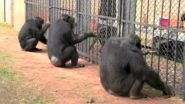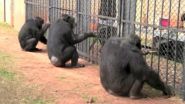(Press-News.org) VIDEO:
Chimpanzees spontaneously cooperate with multiple partners of their choosing to remove a barrier and pull in a tray baited with food.
Click here for more information.
Without any pre-training or restrictions in partner choice among chimpanzees, researchers at the Yerkes National Primate Research Center, Emory University, found for the first time that chimpanzees housed in a socially complex, contained setting spontaneously cooperate with multiple partners of their choosing. This finding, which addresses long-standing doubt about the level of cooperation chimpanzees are able to spontaneously achieve or understand, is published in the June 12 issue of PeerJ.
"Cooperation among primates has attracted considerable research because of the evolutionary implications that such research has for human behavior and the ubiquity of cooperation among wild primates," says lead author Malini Suchak, PhD.
"Cooperation is often regarded as less puzzling than altruistic behavior, but only in an evolutionary sense. In the moment, cooperation often consists of a series of potentially complex decisions involving a choice of partners. When multiple partners are available, an individual must consider with whom to cooperate, if that individual has been a good partner previously, how much to invest in the partner, what to expect in return and if the cooperation will yield more benefits than solitary effort," Suchak continues.
In the study, which included Yerkes researchers Frans de Waal, PhD, Matt
Campbell, PhD, and Tim Eppley, Suchak found the chimpanzees spontaneously cooperated 3,565 times over the course of 94 one-hour sessions. The chimpanzees' success rate and efficiency increased over time, whereas the amount of pulling in the absence of a partner decreased, demonstrating the animals had learned they needed a partner to succeed.
Suchak's study participants were all 11 members of a chimpanzee social group housed at the Yerkes Research Center Field Station in a large outdoor enclosure, which is a more complex environment than typical testing situations. In addition to allowing the chimpanzees to freely choose with which of their group mates they wanted to cooperate, Suchak's study is unique because it included dyadic and triadic cooperation, and it explored the dynamics of female cooperation, all of which can help provide information on the evolution of cooperative tendencies.
The study apparatus required that one chimpanzee (in the dyadic condition) or two chimpanzees (in the triadic condition) remove a barrier in order for another chimpanzee to simultaneously pull in a tray baited with food. The apparatus was mounted to the outdoor enclosure, allowing the chimpanzees to come and go as they wanted within each one-hour session.
"That the chimpanzees preferentially approached the apparatus when kin or non-kin of similar rank were present shows a preference for socially tolerant partners, and this demonstrates that in the midst of a complex social environment, chimpanzees spontaneously initiate and maintain a high level of cooperative behavior," Suchak says.
"Because previous research could only elicit cooperation in a much more controlled setting, we thought more complex, cooperative behavior might have uniquely evolved in humans. This study demonstrates chimpanzees are more cooperative than we realized, and we've yet to fully explore the extent of the similarities between chimpanzee and human behavior in this regard," Suchak concludes.
Established in 1930, the Yerkes National Primate Research Center paved the way for what has become the National Institutes of Health-funded National Primate Research Center (NPRC) program. For more than eight decades, the Yerkes Research Center has been dedicated to conducting essential basic science and translational research to advance scientific understanding and to improve human health and well-being. Today, the Yerkes Research Center is one of only eight NPRCs. The center provides leadership, training and resources to foster scientific creativity, collaboration and discoveries, and research at the center is grounded in scientific integrity, expert knowledge, respect for colleagues, an open exchange of ideas and compassionate, quality animal care.
Yerkes-based research programs are seeking ways to: develop vaccines for infectious and noninfectious diseases; increase understanding of progressive illnesses, such as Parkinson's and Alzheimer's diseases, and develop methods for the earliest possible diagnosis; unlock the secrets of memory; treat and even prevent autism spectrum disorders, fear and anxiety-related disorders, and drug addiction; advance knowledge about the evolutionary links between biology and behavior; and interpret brain activity through imaging.
INFORMATION: END
Chimpanzees spontaneously initiate and maintain cooperative behavior
2014-06-12
ELSE PRESS RELEASES FROM THIS DATE:
All men with gout should be routinely screened for erectile dysfunction
2014-06-12
A new study presented today at the European League Against Rheumatism Annual Congress (EULAR 2014) showed that erectile dysfunction (ED) is present in most men with gout and is frequently severe.1
In a survey of 201 men, 83 had gout, of whom a significantly greater proportion had ED (76%) compared with those patients without gout (52%) (p= 0.0007). Also, a significantly greater proportion of gout patients (43%) had severe ED compared with patients without gout (30%) (p=0.007).1
According to lead author Dr. Naomi Schlesinger, Chief, Division of Rheumatology and Professor ...
Potential anti-TNF response biomarker identified
2014-06-12
DNA methylation has been identified as a potential biomarker of response to etanercept and adalimumab in patients with rheumatoid arthritis (RA) according to preliminary results from one of the largest methylome-wide investigations of treatment response to anti-TNF therapies.1 These data, presented today at the European League Against Rheumatism Annual Congress (EULAR 2014), bring clinicians a step closer to being able to personalise a patient's treatment pathway.
Anti-TNF therapies have proved a huge advance for the treatment of rheumatoid arthritis and have transformed ...
Regular exercise beneficial in suppressing inflammation in rheumatic disease
2014-06-12
Research findings presented today at the European League Against Rheumatism Annual Congress (EULAR 2014) suggest that exercise transiently suppresses local and systemic inflammation, reinforcing the beneficial effects of exercise and the need for this to be regular in order to achieve clinical efficacy in rheumatic disease.
Chronic inflammation, swelling and pain in the joints characterise the more than 200 rheumatic diseases. Persistent inflammation over time can damage affected joints, but previous research has established that exercise can decrease joint inflammation ...
Cranial ultrasound may replace temporal artery biopsy in diagnosis of giant cell arteritis
2014-06-12
A new study presented for the first time today at the European League Against Rheumatism Annual Congress (EULAR 2014), shows that cranial ultrasound has a greater sensitivity than temporal artery biopsy,* and a comparable specificity in the diagnosis of Giant Cell Arteritis (GCA).1
Giant Cell Arteritis (GCA), a condition in which medium and large arteries mainly in the head and neck, become inflamed and narrowed, can cause blindness due to occlusion of the artery supplying the back of the eye. It is therefore essential that a prompt, accurate diagnosis of GCA is made ...
New study sheds light on what happens to 'cool' kids
2014-06-12
Teens who tried to act cool in early adolescence were more likely than their peers who didn't act cool to experience a range of problems in early adulthood, according to a new decade-long study. The study, by researchers at the University of Virginia, appears in the journal Child Development.
While cool teens are often idolized in popular media—in depictions ranging from James Dean's Rebel Without a Cause to Tina Fey's Mean Girls—seeking popularity and attention by trying to act older than one's age may not yield the expected benefits, according to the study.
Researchers ...
Toddlers whose parents use subsidies to buy center-based care more likely to enroll in Head Start
2014-06-12
Children of parents who use subsidies to purchase center-based care in the toddler years are more likely to be enrolled in Head Start or public prekindergarten in their preschool years, according to a new study. The research, conducted at Georgetown University and Columbia University, appears in the journal Child Development.
The federally funded child care subsidy program—the Child Care and Development Fund (CCDF)—serves nearly 2 million children a month and is one of the government's biggest investments in the early care and education of low-income children. While the ...
Cancer drug boosts levels of vascular-protective gene, KLF2
2014-06-12
Case Western Reserve University researchers have discovered that an existing drug used to help cancer patients has the potential to protect thousands of others from the often-deadly impact of vascular clots.
In 2008, the Food and Drug Administration approved bortezomib (Velcade) to treat multiple myeloma, which is a type of bone cancer and mantle cell lymphoma — a particularly aggressive form of non-Hodgkin lymphoma. In addition to attacking cancer cells, the drug has been shown to help prevent clot development common to many forms of the disease.
As hematologist Lalitha ...
Childhood cancer survivors hospitalized frequently years after cancer treatment
2014-06-12
PHILADELPHIA — Survivors of childhood cancers were hospitalized more often and for longer durations because of blood disorders and other problems, many years after cancer treatment was completed, compared with the general population, according to a study published in Cancer Epidemiology, Biomarkers & Prevention, a journal of the American Association for Cancer Research.
"Our findings demonstrate that childhood cancer survivors face ongoing problems that can lead to hospitalization, even for those who are decades past their original cancer diagnosis. This can negatively ...
6,000 steps a day keeps knee OA limitations away
2014-06-12
A new study shows that walking reduces risk of functional limitation associated with knee osteoarthritis (OA). In fact, the study funded in part by grants from the National Institutes of Health (NIH) and published in the American College of Rheumatology (ACR) journal, Arthritis Care & Research, suggests that walking 6,000 or more steps per day may protect those with or at risk of knee of OA from developing mobility issues, such as difficulty getting up from a chair and climbing stairs.
Nearly 27 million Americans age 25 and older are diagnosed with OA according to a ...
Low cholesterol linked with worse survival in patients with kidney cancer
2014-06-12
People are often told to reduce their cholesterol to improve their heart health, but new research suggests that low cholesterol may increase kidney cancer patients' risk of dying from their disease. The findings, which are published in BJU International, indicate that cholesterol testing may help doctors as they monitor and treat patients with kidney cancer.
Increasing evidence suggests that alterations in cholesterol and other lipids are associated with the development, progression, and prognosis of various cancers. To assess the situation as it relates to kidney cancer, ...



